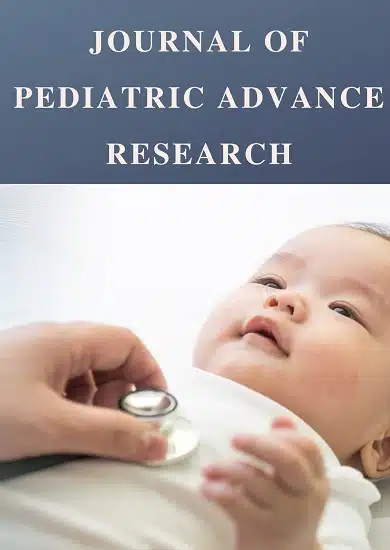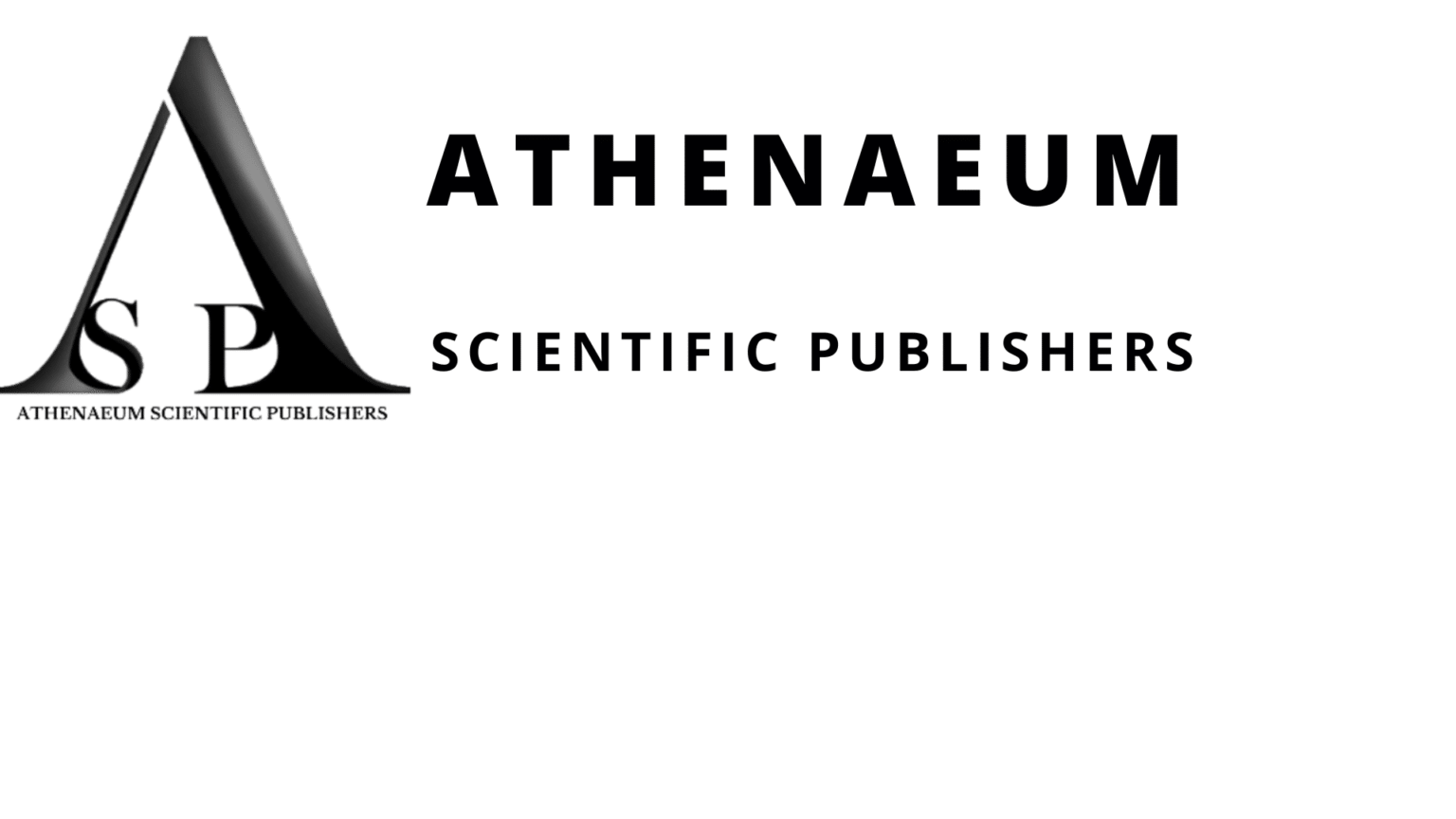Review Article | Vol. 4, Issue 1 | Journal of Pediatric Advance Research | Open Access |
Proposed Protocol for the Focused Analysis of Dengue Fever by Serial Ultrasound in Paediatric Patients: The AEDES Protocol
Edwin Mauricio Cantillano Quintero1, Jesús Domínguez-Rojas2, José Daniel Almazan Monroy1*, Linda Banegas Pineda1, Melissa Portillo Lagos1, Javier Ponce3
1Instituto Hondureño de Seguridad Social: San Pedro Sula, Hospital Nacional Mario Catarino Rivas: San Pedro Sula. Pediatra Intensivista. Honduras, Peru
2Instituto Nacional de Salud del Niño. Jefe de Cuidados Intensivos Pediátricos, Lima, Perú
3Hospital G Rawson, San Juan, San Juan. Pediatra Intensivista, Argentina
*Corresponding author: Jesús Dominguez-Rojas, Pediatrics Critical Care, Instituto Nacional de Salud del Niño, Lima, Perú;
Email: [email protected]
Citation: Quintero EMC, et al. Proposed Protocol for the Focused Analysis of Dengue Fever by Serial Ultrasound in Paediatric Patients: The AEDES Protocol. J Pediatric Adv Res. 2025;4(1):1-10.
Copyright© 2025 by Quintero EMC, et al. All rights reserved. This is an open access article distributed under the terms of the Creative Commons Attribution License, which permits unrestricted use, distribution, and reproduction in any medium, provided the original author and source are credited.
| Received 31 March, 2025 | Accepted 21 April, 2025 | Published 29 March, 2025 |
Abstract
Dengue is a disease caused by a virus transmitted by the bite of infected mosquitoes. It is a disease of public health importance, which represents a problem mainly in countries with tropical and subtropical climates. The clinical picture may vary from a mild form to severe manifestations with potential mortality. The pathophysiology of this disease focuses on vascular leakage as a central element, making the assessment of the severity of this condition an essential component in the care of affected patients. In this context, ultrasound emerges as a tool of great relevance, due to its accessibility and ease of execution at the point of patient care, allowing early interventions and prevention of complications. In this sense, we present a Point-Of-Care Ultrasound (POCUS) protocol for the evaluation of pediatric patients with dengue under the Analysis Focused on Dengue by Serial Ultrasonography (AEDES) strategy. The purpose of this protocol is to establish a comprehensive evaluation sequence that addresses the basic ultrasound windows useful in patients with dengue.
Keywords: Dengue; Ultrasonography; Capillary Leak Syndrome
Introduction
Dengue, a disease caused by a mosquito-borne virus and endemic in many Latin American countries (including Honduras), poses a significant challenge to health systems, especially emergency departments, due to its seasonal epidemic cycles [1]. The pathophysiology of the disease encompasses a complex inflammatory process that can be exacerbated by increased capillary permeability, plasma extravasation and hemoconcentration [2]. In addition, platelet destruction and consumption may contribute to the potential development of hemorrhagic phenomena. Most cases of dengue exacerbation are self-limiting; however, some patients may progress to more severe forms of the disease, characterized by hemorrhage or circulatory shock. Therefore, it is imperative to recognize warning signs, such as hemoconcentration and plasma extravasation, which manifest with symptoms such as abdominal pain and vomiting. Early detection of these signs is crucial for timely and effective implementation of intervention strategies [1,2]. In this context, the advent of Point-Of-Care Ultrasound (POCUS) represents a valuable tool for the evaluation of patients with dengue, as it offers a number of advantages. These advantages include its high sensitivity for the detection of fluid accumulations in various organs and cavities, including the gallbladder. In addition, it is becoming increasingly available and cost effective [3-6].
However, protocols for the expeditious and accurate evaluation of patients with dengue using POCUS as a severity classification tool have not yet been implemented. This publication presents an ultrasonographic protocol, called Analysis Focused on Dengue by Serial Ultrasonography (AEDES), which aims to track alarm signs in patients with dengue [3]. The above protocol would optimize patient care by providing an efficient and targeted approach for the evaluation and follow-up of complications in suspected or confirmed cases of dengue, particularly in resource-limited settings.
AEDES Protocol
The purpose of this protocol is the diagnosis of pathological accumulations of fluid in the body cavities (pleural effusion, ascites and pericardial effusion), which are indicative of critical warning signs in patients with dengue [2]. The purpose is to identify alterations in the gallbladder wall, which is a highly accurate indicator of increased vascular permeability in patients with dengue. In addition, it can serve as a potential marker of disease severity [3]. The purpose is to assess the volume of fluid in the venous and cardiac systems. In each ultrasound window, the purpose is to answer direct binary-type questions, as illustrated in Table 1.
AEDES | Plasma leak patient? | Grade of the POCUS |
Window 1 and 2: Are there signs of interstitial syndrome? | Yes/No | 98% sensitivity Specificity of 88% |
Window 4 and 7: Is pleural effusion present? | Yes/No | 94% sensitivity Specificity of 97% |
Window 3, 6 and 8: Is there an ascites? | Yes/No | 90% sensitivity 99% specificity |
Window 9: Is there a pericardial effusion? | Yes/No | 96% sensitivity Specificity of 98% |
Window 5: Is there thickening of the gallbladder walls? | Yes/No | 94% sensitivity Specificity of 91% |
AEDES: Focal Analysis of Dengue by Doppler Ultrasound, POCUS: Point-Of-Care Ultrasound | ||
Table 1: Questions and answers by fast focused ultrasound.
The use of a convex transducer (2.5 to 5 MHz) is recommended for the application of the AEDES protocol, since it has a superior penetration capacity in deeper structures. The latter has proven to be a very useful tool for the evaluation of cavity leaks. However, the sector transducer is an equally viable alternative. For pediatric pulmonary evaluations, the linear transducer emerges as a readily applicable alternative. In both cases, the default abdominal configuration should be used. It is recommended that the ultrasound equipment be placed on the right side of the patient. This arrangement makes it easier for the operator to hold the probe (or transducer) with the right hand while manipulating the ultrasound control panel with the left hand. The patient should be placed in supine decubitus at zero degrees if tolerated. Implementation of the Trendelenburg position in the patient increases the sensitivity for detection of findings within the upper abdominal windows; however, it is not considered a mandatory requirement. In cases where the patient’s head is positioned at an angle of 30 degrees or greater, there is a tendency for fluid accumulation in the lower abdomen. It is crucial to orient the transducer marker in alignment with the visible marker on the screen. This marker is systematically placed to the patient’s right in the transverse plane and to the patient’s head in the longitudinal plane (Fig. 1).

Figure 1: Useful transducers in AEDES. A: Convex transducer, B: Linear transducer, C: Indicator or mark on a linear transducer (black arrow).
The AEDES is composed of 9 basic ultrasound windows that are shown and described below Fig. 2.
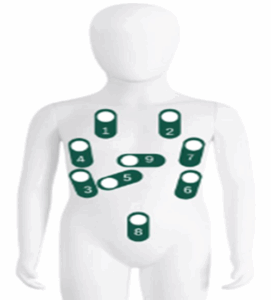
Figure 2: Illustration of protocol ultrasound sites. Window 1 and 2: site of interstitial syndrome; 3 and 4: site of pleural effusion and ascites on the right; 5: site of gallbladder wall; 6 and 7: site of pleural effusion and ascites on the left; 8: site of ascites; 9: site of pericardial effusion.
Window 1 and 2: Pulmonary Interstitial Assessment
The convex or linear probe should be placed in the anterior chest cavity, parallel to the sternum, in the hemiclavicular or parasternal line, with the probe marker oriented cranially (Fig. 3). It is recommended that the hyperechoic pleural line be visualized in the center of the tissue, consistently positioned between the two acoustic shadows of the ribs, utilizing a depth of 3 to 5 cm. The depth should then be adjusted from 8 to 12 cm to assess the presence of B-lines. This step should be performed on both hemithoraces (Fig. 4).

Figure 3: Transducer placement on anterior thorax window 1 and 2.

Figure 4: A pulmonary unit exhibiting a normal pattern of A-lines, devoid of interstitial lung fluid. B and C. The presence of B lines and pleural effusion (identified by the yellow arrow in window 1 and the blue arrow in window 2) is evident.
Window 3 and 4: Assessment of Ascites and Pleural Effusion
The Right upper Quadrant (RQ) is the most sensitive area for the detection of free abdominal fluid. Window 3 represents the initial abdominal region to be examined by AEDES.
To obtain the window, the probe is positioned with the cephalic marker in the posterior axillary line, to the right, at the thoracoabdominal transition (Fig. 5). The posterior acoustic shadow of the ribs may impede visualization of the structures. In such instances, it is necessary to rotate the transducer 15° C to 20° C counterclockwise to fit it between the ribs. Once the structures have been identified, upward and downward movements should be performed while sliding the probe in a craniocaudal direction (Z-shaped movement).
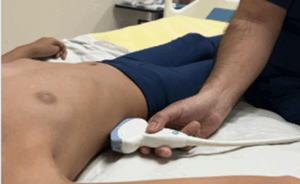
Figure 5: Depicts the optimal transducer position for window 3.
It can therefore be postulated that window 3 can be divided into three distinct regions where free abdominal fluid accumulation may occur: the Morrison’s space, the caudal border of the liver and the suprahepatic space, in that order. The presence of anechoic contents (fluids) within these spaces, as illustrated in Fig. 6, is indicative of a positive AEDES [9,10].
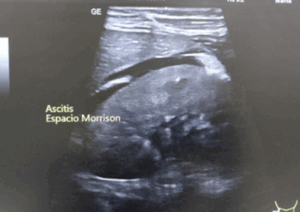
Figure 6: A free fluid is present within the hepatorenal space, as observed in window 3 of the protocol.
Subsequently, following the administration of ultrasound waves via the probe in a cranial direction, the supra-diaphragmatic space is accessed with the objective of detecting pleural effusion. This is window 4 of the protocol, which is used to evaluate the pleural space of the right hemithorax. The presence of anechoic contents above the diaphragm and the finding of the column sign are specific features of pleural effusion, characterizing a positive AEDES (as illustrated in Fig. 7). A recently published systematic review identified the presence of pleural effusion in approximately one-third of patients with dengue, with an increased frequency observed in more severe stages of the disease [4]. Therefore, ultrasound is an effective method for detecting pleural effusion, which can be utilized as a valuable diagnostic tool for severe dengue and risk stratification 6, 16 and 17.
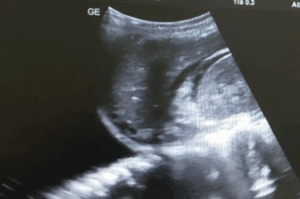
Figure 7: Depicts window 4, which displays an anechoic content above the diaphragm, consistent with the presence of pleural effusion.
The source of this data is: Window 5: Assessment of the Gallbladder Wall. The gallbladder is a mobile structure and can assume a variety of positions within the upper right quadrant (CSD). In order to conduct this assessment, it is necessary to position the probe in the anterior region of the CSD, immediately inferior to the last rib, parallel to the clavicular midline, with the transducer mark oriented towards the patient’s head. The transducer should then be moved up and sideways in a gentle manner, while maintaining contact with the patient’s skin [6,11].
A number of studies have demonstrated that wall thickening is a significant indicator of disease severity in dengue cases, thus making it a crucial element in the AEDES classification system [5,6]. Typically, the gallbladder wall is a thin structure, with a thickness of less than 3 mm. Fig. 8 a gallbladder wall thickness exceeding 3 mm should be regarded as pathological. The objective of AEDES is not to perform a precise measurement of the gallbladder wall; rather, it is to estimate its thickness based on the examiner’s visual impression.
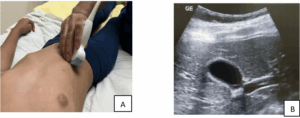
Figure 8: A: Transducer placed below the last rib at midclavicular line; B: Gallbladder in normal condition in transverse axis.
In dengue with severity criteria -and plasma extravasation- the gallbladder wall is thickened and with presence of perivesicular fluid as in Fig. 9.
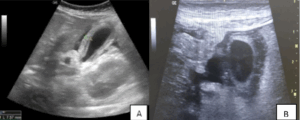
Figure 9: A. Gallbladder in thickened longitudinal window, example shows 7.5 mm B. Gallbladder in thickened transverse window and perivesicular edema.
Windows 6 and 7
Evaluation of ascites and left pleural effusion. The left upper quadrant is evaluated in windows 6 and 7, it consists of four points: pleural space, subdiaphragmatic space, splenorenal space and lower pole of the left kidney. The anatomical reference of the region is the spleen, which is located more posteriorly than the liver in the posterior axillary line, adjacent or adhered to the patient’s bed, with the transducer marking in a cranial direction, performing a smooth sliding and Z movement from bottom to top and viceversa (Fig. 10).
It is important to note that there is active movement of the structures as the diaphragm moves with each breath, so it is necessary to ask for an inspiratory pause and rotate the transducer clockwise to avoid rib artifact.
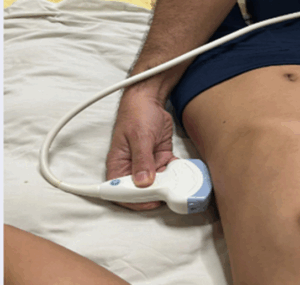
Figure 10: Transducer positioning for window 6 and 7.
The determination of free fluid is observed in the subdiaphragmatic space as well as in the splenorenal space as an anechoic image, then when moving the transducer cranially, a new supradiaphragmatic anechoic image is identified, compatible with probable left pleural effusion, which is considered positive AEDES (Fig. 11) [18,19,24].
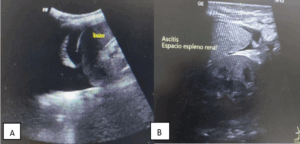
Figure 11: A. Presence of free fluid in the splenorenal space in window 6; B. Presence of anechoic area on the left diaphragm compatible with pleural effusion in window 7.
Window 8: Assessment of Free Fluid in the Pelvic Fossa
In this window we evaluate the retrovesical space, where the full bladder provides the possibility of better vision since it acts as a means of transduction so it can be assessed preferably before placing a bladder catheter.
To make a longitudinal cut, the transducer is placed with the mark towards the cephalic in the suprapubic midline, pendulum movement of the transducer towards the patient’s pelvis. Then, slide the transducer to the right and left by sounding the edges of the bladder to find free fluid (Fig. 12).
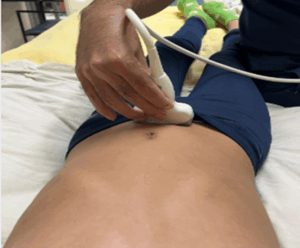
Figure 12: Transducer placement in transverse suprapubic area and rotate transducer longitudinally with the mark or signal towards cephalic.
Then rotate the transducer 90 degrees to make a transverse axis with the transverse axis with the transducer mark to the right of the patient and try to center the bladder on the screen (Fig. 13). Here we can identify the bladder, uterus (women), prostate (men) and colon with a possible finding of retrovesical anechoic structure, which makes it positive for free fluid [18,19,24].

Figure 13: A. Bladder in transverse section with presence of inferior anechoic area compatible with free fluid and ligamentous structures of female organs; B. Bladder in longitudinal section with presence of anterior anechoic area compatible with free fluid.
Window 9: Assessment of pericardial effusion and inferior vena cava. Excellent tool to detect pericardial effusion and cardiac tamponade. It is a very sensitive window and is initiated by placing the transducer on the skin in the subxiphoid space with the marker to the right with a slight rotation to the right shoulder and using the liver as an acoustic window (Fig. 14). At a depth of 15 to 20 cm, the ventricles can be visualized, if not, adjust the depth or apply a little more pressure (Fig. 15).
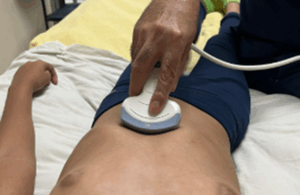
Figure 14: Transducer positioning in subxiphoid space in transverse form of window 9.

Figure 15: The presence of a pericardial anechoic area is positive for pericardial effusion and could be complemented with other cardiac windows of the FOCUS protocol [25-29].
Limitations to this window may include obesity, prominent subxiphoid processes or severe ascites and a full stomach.
Limitations
It is important to emphasize that AEDES does not diagnose or classify the severity spectrum of dengue patients. Likewise, its potential benefit in identifying cases with warning signs, its speed, ease of performance and cost-effectiveness should be taken into account, but whoever performs it should have a certified level of training and have reached an optimal learning curve.
Conclusion
The AEDES is a structured ultrasound protocol for the evaluation of dengue-related complications in the emergency department and emergency physicians, which may aid in knowledge of the evolution and follow-up of patients and contribute to reducing mortality.
Conflict of Interests
The authors have no conflict of interest to declare.
References
- Tambelli RA, Silva PS, Schubert DU, Nogueira VO, Gaspar PL, Oliveira KF, et al. Extended Focused assessment sonography in dengue (E-Fasd): protocolo de ultrassom point of care para avaliação de pacientes com dengue. JBMEDE. 2024;4(1): e24005.
- Tejo AM, Hamasaki DT, Menezes LM, Ho YL. Severe dengue in the intensive care unit. J Intensive Med. 2023;4(1):16-33.
- Motla M, Manaktala S, Gupta V, Aggarwal M, Bhoi SK, Aggarwal P, et al. Sonographic evidence of ascites, pleura-pericardial effusion and gallbladder wall edema for dengue fever. Prehosp Disaster Med. 2011;26(5):335-41.
- Liu RB, Donroe JH, McNamara RL, Forman HP, Moore CL. The practice and implications of finding fluid during pointof-care ultrasonography: A Review. JAMA Intern Med. 2017;177(12):1818-25.
- Van Breda Vriesman AC, Engelbrecht MR, Smithuis RH, Puylaert JB. Diffuse gallbladder wall thickening: differential diagnosis. AJR Am J Roentgenol. 2007;188(2):495-501.
- Chandak S, Kumar A. Can radiology play a role in early diagnosis of dengue fever? N Am J Med Sci. 2016;8(2):100-5.
- Lichtenstein D, Goldstein I, Mourgeon E, Cluzel P, Grenier P, Rouby JJ. Comparative diagnostic performances of auscultation, chest radiography and lung ultrasonography in acute respiratory distress syndrome. Anesthesiology. 2004;100(1):9-15.
- Zaki HA, Albaroudi B, Shaban EE, Shaban A, Elgassim M, Almarri ND, et al. Advancement in pleura effusion diagnosis: A systematic review and meta-analysis of point-of-care ultrasound versus radiographic thoracic imaging. Ultrasound J. 2024;16(1):3.
- Ma OJ, Mateer JR, Ogata M, Kefer MP, Wittmann D, Aprahamian C. Prospective analysis of a rapid trauma ultrasound examination performed by emergency physicians. J Trauma. 1995;38(6):879-85.
- Mandavia DP, Hoffner RJ, Mahaney K, Henderson SO. Bedside echocardiography by emergency physicians. Ann Emerg Med. 2001;38(4):377-82.
- Adil B, Rabbani A, Ahmed S, Arshad I Sr, Khalid MA. Gall bladder wall thickening in dengue fever – aid in labelling dengue hemorrhagic fever and a marker of severity. Cureus. 2020;12(11):e11331.
- Lichtenstein D. Lung ultrasound in the critically ill. Curr Opin Crit Care. 2014;20(3):315-22.
- Volpicelli G. Lung sonography. J Ultrasound Med. 2013;32(1):165-71.
- Koyama H, Chierakul W, Charunwatthana P, Sanguanwongse N, Phonrat B, Silachamroon U, et al. Lung ultrasound findings of patients with dengue infection: a prospective observational Study. Am J Trop Med Hyg. 2021;105(3):766-70.
- Lichtenstein DA. Current misconceptions in lung ultrasound: A short guide for experts. Chest. 2019;156(1):21-5.
- Radonjić T, Popović M, Zdravković M, Jovanović I, Popadić V, Crnokrak B, et al. Point-of-care abdominal ultrasonography (Pocus) on the way to the right and rapid diagnosis. Diagnostics (Basel). 2022;12(9):2052.
- Kaagaard MD, Matos LO, Evangelista MVP, Wegener A, Holm AE, Vestergaard LS, et al. Frequency of pleural effusion in dengue patients by severity, age and imaging modality: A systematic review and meta-analysis. BMC Infect Dis. 2023;23(1):327.
- Venkata Sai PM, Dev B, Krishnan R. Role of ultrasound in dengue fever. Br J Radiol. 2005;78(929):416-8.
- Pothapregada S, Kullu P, Kamalakannan B, Thulasingam M. Is ultrasound a useful tool to predict severe dengue infection? Indian J Pediatr. 2016;83(6):500-4.
- Setiawan MW, Samsi TK, Pool TN, Sugianto D, Wulur H. Gallbladder wall thickening in dengue hemorrhagic fever: An ultrasonographic study. J Clin Ultrasound. 1995;23(6):357-62.
- Nainggolan L, Wiguna C, Hasan I, Dewiasty E. Gallbladder wall thickening for early detection of plasma leakage in dengue infected adult patients. Acta Med Indones. 2018;50(3):193-9.
- Pinto A, Reginelli A, Cagini L, Coppolino F, Stabile Ianora AA, et al. Accuracy of ultrasonography in the diagnosis of acute calculous cholecystitis: review of the literature. Crit Ultrasound J. 2013;5(Suppl 1):S11.
- Sharma N, Mahi S, Bhalla A, Singh V, Varma S, Ratho RK. Dengue fever related acalculous cholecystitis in a North Indian tertiary care hospital. J Gastroenterol Hepatol. 2006;21(4):664-7.
- O’Brien K, Stolz U, Stolz L, Adhikari S. LUQ view and the FAST exam: Helpful or a hindrance in the adult trauma patient? Crit Ultrasound J. 2014;6(Suppl 1):A3.
- Hanson MG, Chan B. The role of point-of-care ultrasound in the diagnosis of pericardial effusion: A single academic center retrospective study. Ultrasound J. 2021;13(1):2.
- Ceriani E, Cogliati C. Update on bedside ultrasound diagnosis of pericardial effusion. Intern Emerg Med. 2016;11(3):477-80.
- Dong M, West FM, Cooper J, Foster J, Davis R. A guide to point of care ultrasound examination of a pericardial effusion. The Medicine Forum. 2023;24(1).
- Fernandes AI, Mendes CL, Simões RH, Silva AE, Madruga CB, Brito CA, et al. Cardiac tamponade in a patient with severe dengue fever. Rev Soc Bras Med Trop. 2017;50(5):701-5.
- Soliman-Aboumarie H, Breithardt OA, Gargani L, Trambaiolo P, Neskovic AN. How-to: focus cardiac ultrasound in acute settings. Eur Heart J Cardiovasc Imaging. 2022;23(2):150-3.
Author Info
Edwin Mauricio Cantillano Quintero1, Jesús Domínguez-Rojas2, José Daniel Almazan Monroy1*, Linda Banegas Pineda1, Melissa Portillo Lagos1, Javier Ponce3
1Instituto Hondureño de Seguridad Social: San Pedro Sula, Hospital Nacional Mario Catarino Rivas: San Pedro Sula. Pediatra Intensivista. Honduras, Peru
2Instituto Nacional de Salud del Niño. Jefe de Cuidados Intensivos Pediátricos, Lima, Perú
3Hospital G Rawson, San Juan, San Juan. Pediatra Intensivista, Argentina
*Corresponding author: Jesús Dominguez-Rojas, Pediatrics Critical Care, Instituto Nacional de Salud del Niño, Lima, Perú;
Email: [email protected]
Copyright
Edwin Mauricio Cantillano Quintero1, Jesús Domínguez-Rojas2, José Daniel Almazan Monroy1*, Linda Banegas Pineda1, Melissa Portillo Lagos1, Javier Ponce3
1Instituto Hondureño de Seguridad Social: San Pedro Sula, Hospital Nacional Mario Catarino Rivas: San Pedro Sula. Pediatra Intensivista. Honduras, Peru
2Instituto Nacional de Salud del Niño. Jefe de Cuidados Intensivos Pediátricos, Lima, Perú
3Hospital G Rawson, San Juan, San Juan. Pediatra Intensivista, Argentina
*Corresponding author: Jesús Dominguez-Rojas, Pediatrics Critical Care, Instituto Nacional de Salud del Niño, Lima, Perú;
Email: [email protected]
Copyright© 2025 by Quintero EMC, et al. All rights reserved. This is an open access article distributed under the terms of the Creative Commons Attribution License, which permits unrestricted use, distribution, and reproduction in any medium, provided the original author and source are credited.
Citation
Citation: Quintero EMC, et al. Proposed Protocol for the Focused Analysis of Dengue Fever by Serial Ultrasound in Paediatric Patients: The AEDES Protocol. J Pediatric Adv Res. 2025;4(1):1-10.

